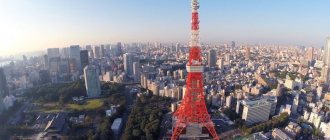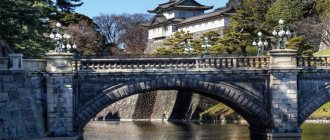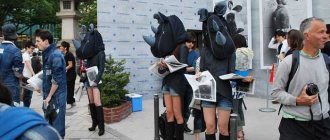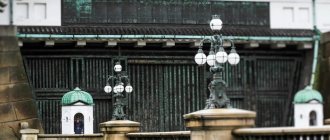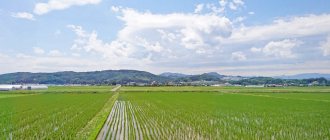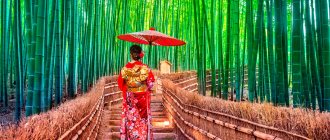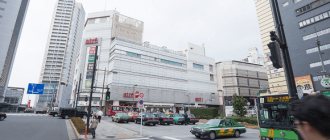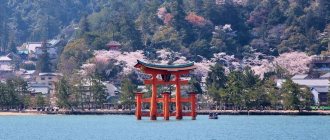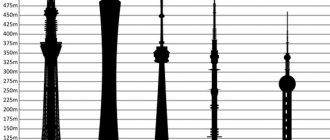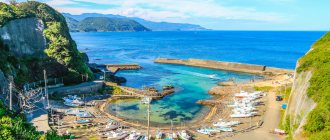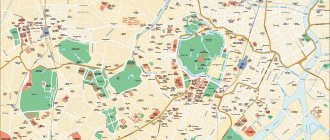Author: Kumamon
24 April 2021 14:13
Tags: Japan Odaiba Odaiba Tokyo Odaiba Island rainbow bridge
484
2
From Tokyo Shinbashi Station, the Yurikamome Monorail runs to the artificial man-made island of Odaiba in Tokyo Bay. The island takes its name from the artillery fortifications erected by the shogun in 1853 to protect Tokyo Harbor from Commodore Peri's "black ships".
0
The ruins of two battery positions are now lost on the island, the construction of which the Tokyo authorities began in 1988. But the economic downturn in the 1990s and the rising cost of construction slowed down the project to build a 21st century city on the island, so when the Rainbow Bridge linked Odaiba to Tokyo in 1993, there were many vacant lots and unfinished construction on the island.
The island of Odaiba is very interesting for tourists: futuristic buildings connected by a monorail, an artificial beach, shady parks and architectural masterpieces make Odaiba so attractive that on weekends it can be difficult to crowd the shopping areas and monorail stations. For foreign tourists, the most interesting is the Maritime Museum and the complex of hot springs with open-air baths - Oedo Onsen Monogatari - more of a thermal park than a bathhouse. The Rainbow Bridge illuminated in the evenings, a giant multi-colored Ferris wheel and the whimsical outlines of skyscrapers against the sky make Odaiba a very romantic place in Tokyo. The easiest way to get to Odaiba is on the Yurikamome Monorail, which loops over Tokyo Harbor before the Rainbow Bridge and stops at all the interesting spots on the island, ending at Ariake Station. If a tourist has the task of exploring the entire island of Odaiba, then it is better to buy a day pass for the monorail line, because walking around the entire island is a very difficult task. In addition, Rinkai Line trains connected to the JR Saikyo Line go to Odaiba Central Station - Tokyo Teleport. Buses depart from Shinagawa Station in the southwest of the bay, cross the Rainbow Bridge and go to the Maritime Museum, stopping at Odaiba Kaihin-koen Park (Odaiba Seaside Park). You can also take a sea ferry from Hinode Sanbashi to Ariake or the Maritime Museum.
Maritime Museum in Odaiba
0
Next to Mirai-kan there is a wonderful Maritime Museum, housed in a concrete building that looks like a cruise ship with a displacement of 60 thousand tons. In the exhibition, in particular, you will see detailed models of ships and engines of huge ships. Nearby in the dock are two real vessels - Soya, which carried out scientific research in the South Pole region, and the sea ferry Yotei Marine, today used as additional exhibition space. On the territory of the museum there are two lighthouses, submarines, a seaplane and two outdoor seasonal swimming pools. Walk around the museum along the shore, pass the oddly shaped triangular tower (this is the ventilation air intake for the tunnel under Tokyo Bay) and you will find yourself in Odaiba Kahin-koen Park (Odaiba Seaside Park) - a very nice park in the dark. The red arrows of the cranes at the container port on the other side of Tokyo Bay are very reminiscent of slender giraffes on the lawn.
Odaiba area
Odaiba is a large artificial island in Tokyo Bay, connected to central Tokyo by the Rainbow Bridge.
Japan is famous for its high-tech structures. One of the most amazing places in Tokyo is the Rainbow Bridge , which runs over Tokyo Bay. The bridge is supported by white pylons, and lamps mounted on the bridge cables bathe it in red, green and white light from dusk until dawn. Combined with a huge number of additional lights, the 570-meter-long Rainbow Bridge is a mesmerizing sight at night.
At the end of every year, Tokyo hosts a unique Odaiba Water Illumination where huge images are projected onto the spray of an underwater fountain located near the Rainbow Bridge leading to the artificial island of Odaiba, creating stunningly beautiful illusions.
The Odaiba district is a young district of Tokyo, built in Tokyo Bay on territory reclaimed from the sea. Thanks to its proximity to the city center - the Ginza district, getting to Odaiba is easy and does not take much time. Lovers of boat trips will enjoy taking a ride to Odaiba on the sea tram, which runs from Hinode Pier in Tokyo (20 minutes on the way) and from Asakusa (55 minutes on the way). Odaiba is a city of the future , this is a kind of utopia, a district of Tokyo on the territory of the port, which was built on the site of a huge garbage dump. Odaiba is a city of celebration , a city of lights, music and entertainment. Streets for pedestrians are laid at the third floor level, and you do not have to give way to cars. Here you can walk along the embankment or above it, admiring Tokyo Bay, go into many shops, and ride the Ferris wheel , which is a kind of magnificent observation deck. There are many interesting objects in the Odaiba area, here is the Fort Venus shopping center, the Toyota Showroom, the Aqua casino, many shops, Japan's largest international complex Big Sight, the Telecom Center observation deck, from which you can admire the panorama Tokyo Bay, the gigantic entertainment complex Aqua City (Aqua City), adjacent to the Odaiba coastal park, as well as the irresistible view of the Reinbow Bridge will leave an indelible impression of Odaiba, various science parks (Nihon-kagaku-mirai Kan (House of the Future of Japanese Science), Fune -no-kagaku-kan (House of Science of Ships) and other entertainments.
One of the tallest Ferris wheels in the world is located in Odaiba, at the PALETTE TOWN amusement park. The Giant Sky Wheel has a diameter of 115 meters and is especially impressive in the evening when it is illuminated with colorful lights. The wheel completes a full circle in 16 minutes. Ticket price is 900 yen.
On the territory of the park there is a bowling alley, karaoke, and, of course, many restaurants and cafes. Right at the foot of the Ferris wheel is one of the world's largest concert venues, Zepp Tokyo. On the second floor of the building there is a specialized beer restaurant. The Toyota Mega Web complex deserves special attention, which car enthusiasts will certainly want to visit. In Mega Web, in addition to the Show-room of the latest Toyota models, there is also a Toyota History Garage with the most famous models of past years. You can even drive the car you like along a specially fenced track.
Odaiba Beach and Tokyo JoyPolis Center
Once you reach the edge of Odaiba Island and the Rainbow Bridge is visible, the area of man-made Odaiba Beach begins. By Japanese standards, this is a pretty good beach, but it’s still wiser to avoid it on sunny weekends, when there are more Japanese people than sand. In front of the beach are the Decks Tokyo Beach and Aqua City shopping complexes. In addition to fashionable shops and restaurants, there is a multiplex cinema complex Mediage, a brewery and a multi-storey Tokyo JoyPolis. Awaken your inner child at this three-story indoor amusement park led by game creator Sega. It combines virtual reality and active attractions, such as a roller coaster, during which you can simultaneously shoot zombies, or an attraction where you can drive real cars. It's best to come here on weekdays, when you don't have to stand in line for long. If you plan to visit many attractions, it is better to buy an unlimited pass. Behind the shopping complex stands the futuristic Fuji TV building, designed by Tange Kenzo, with a huge metal sphere suspended in the middle of the structure. It seems that it is assembled from gigantic parts of a huge children's construction set. Here you can climb to the 25th floor observation deck or spend your money on a cocktail at the Sky Lounge rooftop bar of the neighboring high-rise Grand Pacific Le Daiba Hotel and look at the surrounding views for free. From the string of restaurants near Decks Mall you can get to one of the islands with the remains of the shogunate's defensive structures (now a public park) or go for a walk along the Rainbow Bridge. This is a two-level, single-span suspension bridge with a length of 918 meters. The lower level is dedicated to the monorail and local coastal roads, and the upper level is dedicated to the Tokyo Expressway. On both sides of the bridge there are pedestrian paths connecting the observation halls on the two pillars of this bridge. A walk across the Rainbow Bridge takes about 40 minutes and offers wonderful views. On a clear day you can see Mount Fuji from here. To the west of Odaiba, older sections of reclaimed land devoted to sports dormitories, golf courses and other recreational activities jut out into Tokyo Bay. The most attractive is the Kasai Rinkan Koen Seaside Park, which houses one of Tokyo's largest aquariums and a bird research center, as well as Tokyo Disneyland.
Odaiba Island
Odaiba is a large artificial island in Tokyo Bay. It was originally built in 1851 by order of the Tokugawa shogunate, and was a complex of 6 fortresses capable of protecting Tokyo from attack from the sea. Daiba means "cannons placed on islands" in Japanese. Modern reconstruction of the island began after Tsukaba was chosen as the site of Expo '85. The Japanese economy at that moment was at the peak of its development, and the island was supposed to become an illustration of the Japanese miracle. But after 1991 (“the burst of the soap bubble”), and until 1995, plans for the development of Odaiba were frozen.
In the late 1990s, the area began to gain popularity among Tokyo residents: the first shopping centers, hotels, and business centers appeared in Odaiba, then the largest companies began to move their headquarters here, for example, Fuji Television. In 2002, the new Rinkai railway line began operating, and a few years later the Yurikamome train began running to Toyosu Station. This is how the modern river appeared. Odaiba is a center of recreation and entertainment, popular among both Japanese and foreign tourists.
The main attractions of Odaiba:
1. Fuji TV building.
https://www.fujitv.co.jp/en/
Opening hours: 10:00 to 18:00 (some restaurants until 20:00, on weekends until 22:00). Closed on Monday. Admission: free (observation deck: 500 JPY)
It is the headquarters of Fuji Television, one of the country's largest national broadcasters. You will be able to see some of the scenery from popular programs, buy gifts in the store and go to the observation deck.
2. Telecommunications Center.
https://www.tokyo-teleport.co.jp/
Opening hours: 15:00 to 21:00 (weekdays) 11:00 to 21:00 (weekends) Closed on Mondays. Entrance: 500 JP yen
The Communications Center is the main center of information highways. On the upper floors there is an observation deck, from which there is a beautiful view of the surrounding area, so that on a good day you can even see the city of Fuji.
3. Aquacity Odaiba.
Shops: 11:00 to 21:00 Restaurants: 11:00 to 23:00 (some restaurants until 4:30).
https://www.aquacity.jp/en/top
Aquacity is a shopping complex with a large selection of shops, restaurants and cafes, not to mention a cinema that meets the latest technical requirements. The wooden deck opposite Aquacity and neighboring decks offer beautiful views of the Rainbow Bridge.
4. Decks Tokyo Beach.
https://www.odaiba-decks.com/
Shops: 11:00 to 21:00 Restaurants: 11:00 to 21:00 (some restaurants until 24:00).
A shopping center with numerous boutiques, cafes, restaurants, shops. Includes two theme parks - Tokyo Joypolis and Legoland Discovery Center, as well as a Madame Tussauds wax museum and art gallery.
5. Venus Fort.
https://www.venusfort.co.jp
Opening hours: 11:00 to 21:00 Restaurants: 11:00 to 23:00.
The shopping center houses more than a hundred shops, cafes and restaurants. The interior design of the center bears the features of southern European cities of the 18th century.
6. DiverCity Tokyo Plaza.
https://www.divercity-tokyo.com/en/
Shops: 10:00 to 21:00 Restaurants: 11:00 to 23:00
This is a new shopping and entertainment center that opened its doors in April 2012. The main attraction is the Gundam statue from the anime "Life sized".
7. Museum of Marine Sciences.
https://www.funenokagakukan.or.jp/
Hours: 10:00 to 17:00 (entrance until 16:30). Closed on Mondays. Currently, while the museum is under renovation, entry to the ships is free.
The museum looks like a large cruise ship moored to the embankment of the island. Odaiba. The main building with exhibits on the history and technology of ships and shipping is currently closed for renovation. Also next to the museum there are always two real ships.
8. Rainbow Bridge.
The Rainbow Bridge, or Rainbow bridge, serves as a buffer between Odaiba and the rest of Tokyo. The double-decker bridge is a symbol of the bay and is especially beautiful in the evening with night lighting. The bridge has an expressway, a regular road, the Yurikamome line and pedestrian paths on both sides.
9. Oedo Onsen Monogatari.
https://www.ooedoonsen.jp/daiba/
Opening hours: 11:00 to 21:00 (entrance until 19:00). Admission: JPY 1,980 (JPY 1,480 after 6 p.m.).
Oedo Onsen Monogatari - an onsen, or as it can be described in a European manner, a Japanese “spa”, was opened in 2003. The interior design of the onsen is imbued with the atmosphere of the Edo period, with characteristic baths and springs. The best massage and treatment rooms are at your service, and visitors also have the opportunity to dine at the excellent onsen restaurant.
10. Leisureland entertainment center.
Opening hours: 10:00 to 23:50.
A huge entertainment complex where you can play bowling, slot machines, table tennis, karaoke and much more.
The complex also features a ninja house and a haunted house.
11. National Museum of the Development of Science and Innovation.
https://www.miraikan.jst.go.jp/
Opening hours: 10:00 to 17:00. Closed: Thursdays Admission: 600 JPY.
The National Science Museum hosts exhibitions on robotics, environmental issues, information technology, space exploration, and biology. For foreign tourists, booklets are available in English.
12. Toyota Mega Web.
https://www.megaweb.gr.jp/English/
Opening hours: 11:00 to 21:00.
The Toyota showroom showcases the latest car models, accessories, as well as the latest developments and technologies. At the Toyota Museum you can see cars from past decades.
13. Tokyo Big Sight.
https://www.bigsight.jp/english/
Tokyo International Exhibition Center (Tokyo Big Sight) is the largest exhibition center in Japan and one of the most daring architectural creations of Odaiba.
A wide range of events are held at Big Sight throughout the year, including the Tokyo International Anime Expo and the Tokyo Motor Show.
14. Ferris Wheel.
Opening hours: from 10:00 to 22:00 (until 23:00 on Friday and Saturday). Entrance: 900 JP yen
The height of the Ferris wheel is 115 meters. It is one of the largest in the world. It offers a good view of Tokyo Bay and Odaiba Island in general. Each cabin has 6 seats, a full rotation of the wheel takes about 15 minutes.
15. Panasonic Center.
Opening hours: from 10:00 to 18:00. Closed on Mondays.
Panasonic Center is a showroom for the latest products and technologies presented by Panasonic Corporation. The exhibition features the latest televisions, computers, games, household appliances and much more. On the third floor there is the Museum of Natural Sciences.
How to get to Odaiba:
Yurikamome train.
Yurikamome is an automated driverless train that connects Shimbashi Station on the Yamanote Line and Toyosu Station on the Yurakucho Subway Line. Trains depart every few minutes and the journey between Shimbashi Station and Daiba Station takes 15 minutes and costs 310 JPYen. On the way to Odaiba, the Yurikamome train crosses the Rainbow Bridge, offering beautiful views of the harbor and Tokyo waterfront.
Rinkai Line.
The Rinkai Line connects Osaki Station (JR Yamanote Line) with Shin-Kiba Station (JR Keiyo Line) with stops at Tokyo Teleport and Kokusai Tenjijo Stations. Travel from Shinjuku to Tokyo Teleport Station on the island. Odaiba takes 25 minutes and costs 480 JPY. yen Please note that the Japan Rail Pass, Seishun 18 Kippu and similar JR tickets are not valid on the Rinkai Line between Osaki Station and Shin-Kiba, although the line is served by JR trains.
Water taxi.
The Tokyo Water Taxi departs from Odaiba Seaside Park Station to Hinode Pier (20 minutes journey, cost 460 JPYen). You can also take a water taxi to Odaiba from Asakusa (journey time - 50 minutes, cost - 1,520 Japanese yen).
On foot.
You can take a walk along the Rainbow Bridge. The walk will take about 30-45 minutes. The Rainbow Bridge offers a beautiful view of the surrounding area and the embankment. The walking path starts a short walk from Shibaura-futo Station. Bicycles are prohibited on the bridge. Please note that the footpaths are closed between 21:00 and 9:00 am from April to October; from 18:00 to 10:00 from November to March and on the third Monday of each month.
Odaiba. Greater Edo Baths: Past and Present. Oedo Onsen Monogatari
The cleanliness of the Japanese is known all over the world. It is illustrated by photographs from albums of post-war views of Tokyo, depicting Tokyo residents sitting in metal barrels of hot water installed in the middle of a burnt-out wasteland. Talking animatedly, Tokyo residents take baths in round barrels and rectangular tin tanks installed at the well. Together with the dirt, they wash away tension and fatigue from their bodies. Naturally, at that difficult time for the country, the water in these containers was not completely changed, but only the top cloudy layer was scooped out with a ladle and, after adding hot water, they were immersed in the bath. Nowadays I don’t even want to think about the purity of the water in such baths, but at that time, for those people, a bath even with such water was an event. Their happy faces in the photographs indicate this. Later, improvised barrel baths were replaced by baths shaped like a Goemon cauldron. This name comes from the famous bandit Ishikawa Goemon from the era of Azuchi Momoyama (1568-1600), who was boiled alive in boiling oil for his atrocities with his family and band of bandits. First, a fireplace is built, a boiler large enough to accommodate a person is placed on top, wood is lit under it and water is heated. The bottom of the cauldron, naturally, gets very hot, so the person who climbs into this cauldron places a round board-lid under his feet. In such a bath, the main thing is to be able to slowly lower yourself into the water without allowing the wooden lid to float up, holding it with your feet and balancing on it. After this, you can plunge into the bath up to your neck (and not just up to your chest, as is now customary) - and enjoy the blissful warmth throughout your whole body. And finally, the time came when public baths - sento - began to be revived in Tokyo. If you ask yourself where the Tokyo public baths come from, then you must admit that their construction in Tokyo began much later than in Kyoto and Osaka, and, perhaps, the “first sign” can be called a public bath built in 1591 not far from the present Edogawabashi Bridge over the Kandagawa River. Over time, public baths became increasingly popular among the population and became widespread, so that by 1937 their number had reached about 3,000. However, in 1945, as a result of the aerial bombing of Tokyo, the number of baths in the city was sharply reduced to only about 400. It was precisely this shortage of sento, As a consequence of air raids, improvised tin baths and later Goemon boilers were called upon to compensate. As peace returned and the economy recovered, the number of Tokyo public baths began to grow steadily, reaching its peak in 1968 with 2,687 establishments. At that time, most Tokyo houses did not have bathrooms, so it is not surprising that almost all city residents, regardless of gender, social status and age, used public baths. When, thanks to the rapid growth of the Japanese economy, private bathrooms became common in homes, the existence of public baths was threatened. Their numbers fell every year, and in 2008, in Shitamachi, the business and commercial part of Tokyo, which once had 2,700 bathhouses, there were only 900 of them left. Yet the Japanese love for sento, passed down through generations, has not disappeared. In the second half of the eighties of the 20th century, “supasento” or “super-baths” appeared on the scene. Thanks to the development of Japanese drilling technology, the previous generation of public baths, powered by tap or well water, became supasento with natural hot springs. According to the Tokyo Bath Association, there are a large number of hot springs in the underground layer of Tokyo, and wells can be drilled to them almost anywhere. The water in them has a coffee color and a rather pungent smell; this water cures neuralgia, rheumatism and many other diseases. In multifunctional establishments of the new type of soup-sento, in order to maintain traditions and maintain a close connection with ordinary citizens, the appearance of the building was left unchanged, but large parking lots were equipped to accommodate visitors coming from afar. In addition to the usual for traditional sento, there are open-air rotenburo baths and European saunas. In addition, there are comfortable lounges and snack bars. But the most attractive thing about such baths is the relatively low cost of visiting with the widest range of services, which allows the Japanese to visit them with their families, spending several hours in these establishments. However, these public baths were transformed again. In the wake of the Japanese desire for a healthy lifestyle, luxurious kenko spas - “health spas” - emerged. A home bath, no matter how hard you try to diversify it with aromatic additives or mineral salts, remains just a home bath. Any person doesn’t mind maintaining their youth, health and beauty, even if it requires some money. Wellness spas that meet this desire are very different from “super baths.” You can judge the sophistication of the spa by the list of services offered here. Only the entrance fee to kenko spa is several times higher than to supasento. What can we say about services, the foreign names of which, written in katana alphabet - body cleaning, reflexology, thalassotherapy - are difficult for an ordinary Tokyoite to understand without an appropriate explanation, accompanied by a photograph. Such spas are constantly at the peak of their time, offering visitors of different ages the latest achievements in the field of wellness services. Ooedo Onsen Monogatari, whose name can be translated as “The Tale of the Greater Edo Hot Springs,” occupies a very special place among the health facilities of Tokyo - an onsen (hot spring) and at the same time a theme park, which opened in 2003 in the Tokyo seaside center of Rinkai-Fukutoshin. Today, when a large number of theme parks are closing due to unprofitability, this establishment does not lose its popularity, the secret of which is the enduring love of the Japanese for hot springs. Stretch out to your full height in a huge hot bath, spare no water to wash away fatigue and tension, and put a towel on your head and relax. But the most attractive thing about this institution for any visitor, be it Japanese or foreign, is to be transported back in time, turning into a city dweller of the Edo era. The secret of the magical “time jump” effect is the light yukata kimono and obi belts offered at the entrance in 19 colors to choose from, which all visitors wear. After changing clothes, they go out into a hall that imitates Hirokoji Street from the Edo era, with an old fire tower. Having tried yourself in ancient games, such as throwing shurikens, shooting from blow pipes, throwing rings, everyone will feel like a real Edossian. Both Japanese and foreigners will always feel the atmosphere of another era when entering Oedo Onsen Monogatari. On Hirokoji Street there are souvenir shops and various catering establishments with delicious Japanese cuisine, while enjoying which you can watch various show performances from animators. Now, Tokyo residents and guests do not necessarily have to travel far from the capital in search of hot springs. Oedo Onsen Monogatari is just 20 minutes away via free buses from Tokyo and Shinagawa Stations or the Yurikamome Monorail from Shimbashi Station, passing over the famous Rainbow Bridge. In the establishment itself, visitors have access to 14 varieties of different baths, from open-air rotenburo, cypress wood barrel baths, saunas to foot baths, hot stones and sand baths. Thus, having traveled a very simple path, anyone can fully enjoy the atmosphere of a real hot spring in this place - a Japanese onsen. Very close to Oedo Onsen Monogatari there are modern hotels, a shopping center, Odaiba coastal park, and a theater. In this unique place, the Japan of the past and the Japan of the present and future simultaneously appear before your eyes, which is always appreciated not only by the Japanese, but also by numerous foreign tourists.
Sights of Odaiba
There are many interesting places in Tokyo, but you will remember your visit to the ultra-modern island for a long time!
Real miracles begin already at the entrance to Odaiba. The island is served by automatic trains called Yurikamome. Unmanned trains cross the bay on the spectacular Rainbow Bridge , which has two floors and is more than 900 m long.
The first things that catch your eye are the original buildings, exhibition centers . On the island of Odaiba in Japan there is a copy of the Statue of Liberty, which is 4 times smaller than the American original. Tokyo Joypolis entertainment complex offers many attractions , and the residence of Fuji Television houses an observation deck and observatory.
Standing in front of the entrance to the Diver City Tokio Plaza is the robot Odaiba . The giant transformer Gundam Unicorn depicts the popular anime series character Mobile suit Gundam, which is considered one of the tourist icons of Japan.
Do you want to relax like Japanese? Experience the oasis of entertainment - Odaiba Onsen Monogatari . There, tourists change into kimonos, get acquainted with the bathing culture of the Land of the Rising Sun and try local delicacies. Find selected information on prices on the official website of Onsen Obaibo.
To see all the sights from a height of 115 m, take a ride on the Odaiba Ferris wheel. The Giant Ski Wheel makes a full circle in 16 minutes. Tickets for adults cost 1,000 yen, and for children aged 4 to 11 years old, 500 yen.
Replica of the Statue of Liberty (Photo: @jezael / unsplash.com)
